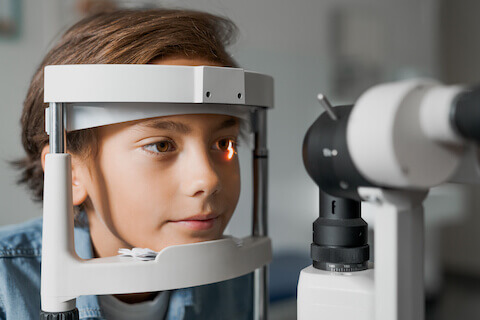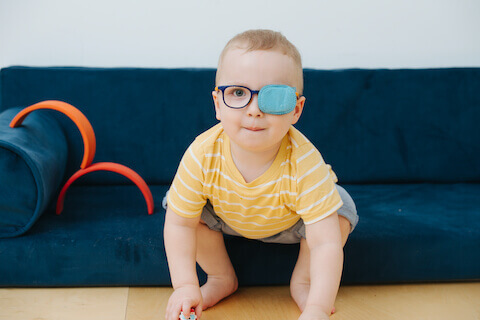
The visual system develops rapidly during childhood and adolescence, and deficiencies during this time can have lifelong impacts on vision. In their younger years, children will often adapt to their vision as it is, however good or bad it is, and perceive this as “normal”. Hence, screening eye exams are imperative in the toddler and childhood years.
When should I get my child’s eyes checked?
Even if there are no vision problems, routine examination by an ophthalmologist is highly recommended before a child starts preschool/kindergarten, before middle school, before high school, and before college. This is to ensure that there are no eye problems that may hinder learning. If a child fails a vision screening test at the pediatrician’s office, has symptoms such has blurry vision, pain, redness, discharge, squinting, wandering eyes, poor tracking, or any difficulties with learning, he or should see an ophthalmologist.
What should I expect during the exam?
Ages 0 to 5yrs
Pediatricians will routinely perform vision screening exams on infants and toddlers during their post-natal visits and during annual physical exams. For children too young to read, the eyes can be screened using a hand held device that picks up abnormalities in refractive error, pupil reflexes or alignment of the eyes. If the child fails this screening, then referral is made to an ophthalmologist for further evaluation.
With an ophthalmologist, the vision will be assessed either by observing the child’s response to light/objects, or by having the child read a “picture” chart. Pupil reflexes, ocular movements/tracking and alignment will be checked. The eyes are then dilated for a complete examination of the inside of the eye (lens, retina, blood vessels and optic nerve) using magnifying lenses. The refractive error, or “glasses prescription” is measured using a technique called retinoscopy. The ophthalmologist uses lenses of varying powers to neutralize the light reflected through the dilated pupil using a hand held light source called a “retinoscope”.
Most young infants and toddlers tolerate the eye examination comfortably with minimal distress, and even some enjoyment. Rarely, if a child is not cooperating by engaging with examiner, they may need to be briefly but gently held down for a few seconds to allow for thorough examination.
Ages 5-12
This is a period of rapid growth. Children are animated and responsive at this age, and engage well with the eye exam. Vision screenings can be easily performed with a vision chart. Besides the testing described above, children are also assessed for color deficiencies and for stereo-acuity, or 3D vision. The eyes are also dilated with eyedrops before measuring the prescription with retinoscopy. A more detailed slit-lamp examination (ie looking at the eyes through an illuminated microscope) can be achieved.
Ages 13-18
Youth of this age are able to perform all aspects of the eye examination easily, as an adult. Prescriptions are still measured after dilating the eyes. Up to the age of 18yrs, the focusing muscles inside the eye are so strong that it is necessary to relax them completely before measuring a prescription accurately. Also, dilation is required to assess the retina completely. Contact lens fittings are also offered, for those interested, by our optometrists.
What are some common pediatric eye conditions we treat?
Refractive Errors
If a child needs glasses to see clearly, this need must be addressed, especially between the ages of 0 and 9yrs old. During these early years, the vision center is the brain is developing rapidly. If the eye does not transmit a clear image to the brain, then the vision center does not develop the resolution to see 20/20. If this brain development is not corrected before the age of 9-10yrs, the brain is never able to recover to 20/20, even if glasses are provided at a later age. This leads to a condition called Amblyopia.
Refractive errors in general become more common as children grow older. It is estimated that about 8% of children have hyperopia, 15% have astigmatism, and 25% have myopia in the United States. Hence, almost half of all children require some kind of vision correction.
Amblyopia

Amblyopia, or “lazy eye” is when the vision in one or both eyes does not develop properly during childhood. Time is critical with amblyopia. If not addressed before the age of 9 or 10yrs, vision deficiencies can be permanent.
Causes of amblyopia include uncorrected refractive errors, strabismus (wandering eyes), cloudiness in some part of the eye, or eyelid drooping. If there is an underlying cause, then that needs to be addressed first. This often involves something as simple as prescribing glasses. Less frequently, further interventions such as muscle, cataract or eyelid surgery need to be performed. Rarely, there are untreatable conditions of the eye that lead to irreversible amblyopia.
If the weakness in vision is one-sided, other strategies like patching the stronger eye, or using dilating eyedrops (ie Atropine 1%) to “blur” the stronger eye may be employed.
Up to the age of 9yrs, amblyopia required close management and follow up. Children are often seen by an ophthalmologist every 3mths to track their vision and ensure improvement.
Strabismus
Strabismus affects 2-5% of the population, and manifests as crossing in (Esotropia ), wandering out (Exotropia) , or vertical deviations (Hypertropia or Hypotropia) of one or both eyes. These misalignments can be tricky to detect, so if there is any suspicion, evaluation by an ophthalmologist is recommended.
The first step in managing strabismus is to ensure that the vision is optimally corrected (ie with glasses or contact lenses). Some types of strabismus, like accomodative esotropia, respond well to bifocals. Other forms, like convergence insufficiencies, can be managed conservatively with simple eye exercises called “pencil push-ups”. Patching one eye, or blurring the vision in one eye with eyedrops, is another way to help control and improve the muscle weakness over time.
If all conservative measures fail, then surgery becomes an option. Again, early detection and intervention is key to managing muscle disorders, and many children may avoid surgery if treatment is initiated when they are young.
Rapidly Progressive Myopia
This is a relatively newer condition managed by ophthalmologists, precipitated by the increase in near work at young ages while vision is developing. Myopia is when children are unable to see clearly far away without glasses. The rate of myopia in the United States has almost doubled in the past 20yrs. As a child grows, myopic prescriptions slowly increase, then stabilize between the ages of 18 and 22yrs in most cases. If the prescription is increasing by more than 1.0 diopters per year, then it is called “rapidly progressive”. Severe myopia can be associated with a higher chance of long-term eye problems like retinal detachments or glaucoma.
Today, there are interventions that have been proven to slow down the progression rate of myopia. Behavioural changes, like reducing the amount of near work and increasing the amount of time spent outside in natural light, can help tremendously. Other treatments ophthalmologists offer include using dilute atropine eyedrops between the ages of 5 and 12yrs. In October 2019, the FDA approved a soft contact lens called MiSight for reducing myopia progression.
Infections and Allergies
Almost no child can grow up without getting an eye infection. Redness, discharge, pain light sensitivity or swelling in the eyelids are some common signs. We treat the full range of possible eye infections, from conjunctivitis (bacterial or viral), keratitis, chalazia, cysts, to eyelid cellulitis. Ocular allergies are also very common in children, and are distinguished by itching, watering and redness. A range of eyedrops are available for treatment depending on the severity of the condition.
Not uncommonly, a non-contagious disease called blepharitis can mimic the appearance of “pink eye”. This is a chronic, recurring inflammation of the meibomian glands that line the eyelids, and can lead to excessive oily secretions from the glands, crusting, chalazion formation, dryness, infections in the cornea, and blurry vision.
In every case of a pediatric red eye, an eye exam is important to be able to determine the cause so that appropriate treatment may be instituted.
Tear Duct Obstruction and Tearing
Nasolacrimal duct obstruction is typically seen in neonates due to incomplete opening of the nasolacrimal duct at birth and manifests with tearing. Conservative management often results in successful resolution with time, but infections due to this must be treated with antibiotics. Failure to resolve spontaneously may require surgery when the infant is between 12-18mths of age.
Trauma
The high activity level of in youth leads to the potential for more instances of eye trauma. Blunt trauma from balls or baseball bats is common. All cases of blunt trauma to the eye or eyelids should be evaluated as they could lead to orbital fractures, inflammation in the eye (iritis) , bleeding in the eye (hyphema or vitreous hemorrhage), retinal tears or detachments, and rarely a ruptured globe. Eyelid lacerations and corneal abrasions can be caused by impact with sharper objects. Small foreign bodies can sometimes become lodged in the eye or socket and lead to discomfort and pain. Many sports injuries can cause concussions. Concussions have been associated with double vision, headaches, and problems focusing to read. Sometimes visual aids are necessary to help the child as recovery can take weeks to months.
Learning Disabilities
All children and teenagers with learning disabilities like autism, Down’s syndrome, ADHD etc should have their vision evaluated annually to ensure there are no weaknesses. The eye exam is mostly objective and does not rely on much feedback from the patient. Moreover, these youth may not realize or report if they are having a problem with their vision which can hamper their learning and functioning. Hence, screening is even more important.
Autoimmune disease and Diabetes
Young people who suffer from autoimmune disease, such as Juvenile Rheumatoid Arthritis (JRA), Systemic Lupus Erythematosis (SLE), Type 1 Diabetes etc., must have their eyes screened at regular intervals from every 3mths to annually depending on the condition. Such diseases can cause uveitis, or inflammation, in the eyes which is largely asymptomatic in children, but has the potential of causing serious long term problems like glaucoma or cataracts. When diagnosed by proper examination by an ophthalmologist, treatment can be started to stop the inflammation and prevent other complications. Screening, therefore, is imperative. Diabetics also require at least annual screenings of the retina.
Eyelid defects, Growths and Tics
The eyelids perform an essential function or protecting and lubricating the eyes. Sometimes, the eyelid is droopy from birth, a condition called ptosis. This can endanger the vision by blocking visual input and may lead to amblyopia. While close monitoring suffices for mild cases, sometimes surgery is warranted. Certain syndromes, such as blepharophimosis syndrome, are defined by droopy eyelids.
The shape of the eyelids can also given an appearance of pseudostrabismus, or apparent crossing in of the eyes. This condition typically improves with age. If the lower eyelid is too tight, it can lead to inward turning of the lower eyelashes, called epiblepharon, and warrants careful monitoring of the cornea for ulcers or abrasions.
There are a host of benign growths that can appear on the eyelids, such as a chalazion, hordeolum, molluscum contagiosum, and benign inclusion cysts. Some require excision, while others can be managed with medical means.
A fairly common complaint assessed in the office is one of “excessive blinking”, “twitching of the eyes” or “rolling up the eyes”. The incidence of such occurences is rising, and perhaps may be related to the increase in screen time in children these days. These disturbances are known as benign motor tics, and tend to be most common between 4 and 10yrs of age. Before this diagnosis is made, other causes for the above symptoms, for instance eye allergies, must be excluded. Fortunately, ocular tics tend not to preempt more serious eye disease, and will in most cases subside spontaneously within a few weeks.
Glaucoma
While glaucoma is rare in the pediatric age group, detection and treatment can help prevent irreversible vision loss and blindness. Evaluation for all ages is offered at our office, and when appropriate, eye pressure checks, OCT imaging of the optic nerves and automated visual field testing are available for diagnostic purposes.
Cataracts
Cataracts are also uncommon in children. Congenital cataracts afflict neonates at birth and prompt surgery is required to allow vision to develop normally. Smaller lens opacities may be observed without surgery if the vision is not completely occluded. These can be present at birth, can be secondary to other genetic defects, can be due to metabolic disorders, or can be induced by trauma. Even if surgery is not required, careful follow up and treatment of amblyopia, if present, must be instituted.
Rare Pediatric Eye Diseases
Below are listed some uncommon conditions that we monitor. The list is not exhaustive, but delves into some rarer disease that an ophthalmologist might encounter in a pediatric setting.
- Peter’s Anomaly and Iris defects
- Keratoconus
- Marfan’s syndrome
- Neurofibromatosis
- Colobomas of the iris or optic nerve
- Conjunctival Nevus
- Capillary Hemangiomas
- CHARGE syndrome
- Blepharophimosis syndrome


